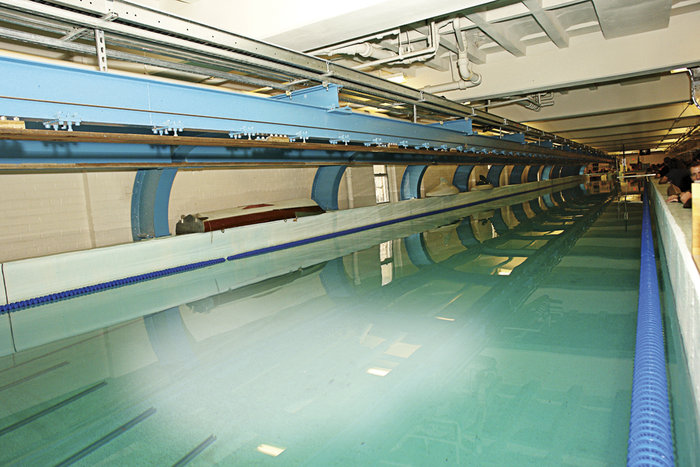“So, do you believe in climate change, or what?” asks Dr. Alan F. Blumberg, as I enter his spacious office at Stevens Institute of Technology. It’s 100 degrees out—the hottest day of the year—and that heat stalked me as I wandered through Stevens’s hilly campus, which is home to breathtaking, panoramic views of the Hudson River.
As Director of The Center for Maritime Systems, Blumberg is thinking about climate change a lot these days. Specifically, he studies how climate change affects coastal cities and waterways like New York Harbor, which, he points out, is the busiest harbor on the East Coast.
Important as it is, climate change is just one element of the Center’s work at Stevens, but it’s fresh on his mind as we sit down to chat. For one, his visitor is about to faint from what could very well be the effects of climate change. More important, he’s just hosted a conference for government, municipal, and scientific leaders that aimed to find ways to better deal with hurricanes, rising sea levels, and other dangerous outcomes of changes in climate. Down-to-earth and accessible, Blumberg seems as passionate about local and practical applications of his work as he is about the ocean itself. Which is a very good thing for our waterfront community. Urban coastal settings like Hoboken, Blumberg tells me, are especially vulnerable to harm from natural disasters because they’re densely populated areas that are open to attack from both sea and sky.
Besides trying to protect us from natural disasters, Blumberg’s team works to shield our waters from dangers of the manmade variety. In order to protect harbor ships from terrorism, Blumberg oversees a cutting-edge network of robots that transmits information to one another underwater. Big development, says Blumberg, since prior to this it was only “dolphins that could communicate underwater.” (We’re not talking about scuba divers waving to their pals.)
Blumberg suggests we take a walk downstairs to the wave tank, so he can explain the Center’s commercial, for-profit component. “You want a fast boat,” he says, “you come to us.”
On the ground floor of Stevens’s Davidson Laboratory Building lies a 300-foot long, 12-foot-wide wave tank. Here, boats are built to scale then tested in shallow water, and at different wave simulations. Built in 1945, the tank was once used by the U.S. Navy to investigate the possibilities of seaplanes. In later years, it was used to test scale models of racing yachts that competed in the America’s Cup. Now, fishermen, the Coast Guard, and sailboat racers use it—anyone with a pressing need for speed along the coast.
Back in his office, Blumberg clicks on a gigantic computer screen and pulls up a massive, multi-colored map. As I peer closer, I realize we are looking at the New York and New Jersey coastline, separated into regions. With a system of sensors and monitors deeply embedded all along the coastline, the Blumberg team measures the direction of currents, water temperature, waves, salt levels—anything and everything related to the water. The system can forecast conditions and activity 48 hours in advance, a huge plus for those who log on regularly to check out conditions—everyone from surfers, kayakers and swimmers to lifeguards, sailors, fishermen, racers, police officers, and Port Authority personnel. (Note to self: log on to hudson.dl.stevens-tech.edu/maritimeforecast next time I want to go body surfing at the Shore).
It’s easy to see why swimmers and sailors benefit from a heads-up on tides and currents. But fishermen, too, can use the water’s salt levels to help them find the best fishing grounds. That’s because fish swim away from the highest concentration of salt, Blumberg explains. A colleague of Blumberg recently developed an iPhone app that helps lifeguards track riptides. But police officers? The busiest waterway on the East Coast is sometimes home to heartbreaking accidents and criminal activity. Knowledge of the waters can’t always prevent tragedy, but it can help authorities locate missing clues.
On a foggy Christmas Day in 2005, two Jersey City police officers drove their vehicle off a drawbridge into the Hackensack River. The body of Officer Shawn Carson was found that night. But rescuers searched for four days before they were able to recover the body of Officer Robert Nguyen. Blumberg directed the rescuers to search downstream, near the base of the bridge, where the currents had taken the body.
Blumberg was also on call on the merciful day in 2009 when US Airways Flight 1549 ditched in the Hudson. He contacted officials and told them to tow the plane south, where the current would be slowest, and they would meet with little resistance.
Blumberg clearly revels in his work and his role at Stevens. With Hoboken Mayor Dawn Zimmer a frequent visitor to the campus, Blumberg is optimistic about the Institute’s growing involvement in the Hoboken community.—07030
